Turpeth, TurbithTurpethumTrivrita, Tri-vrta (Ayurveda) Nishoth (Hindi) Turbud, Turbud Mujaffif, Turbud Safed (Unani) |

|
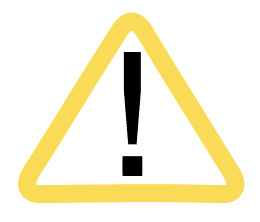
|
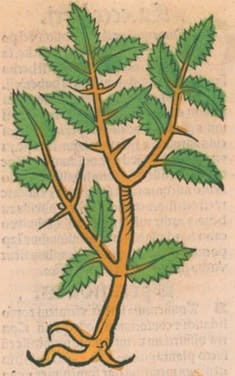 Arabian Turbith
Arabian TurbithOrtus Sanitatis, Meydenbach, 1491
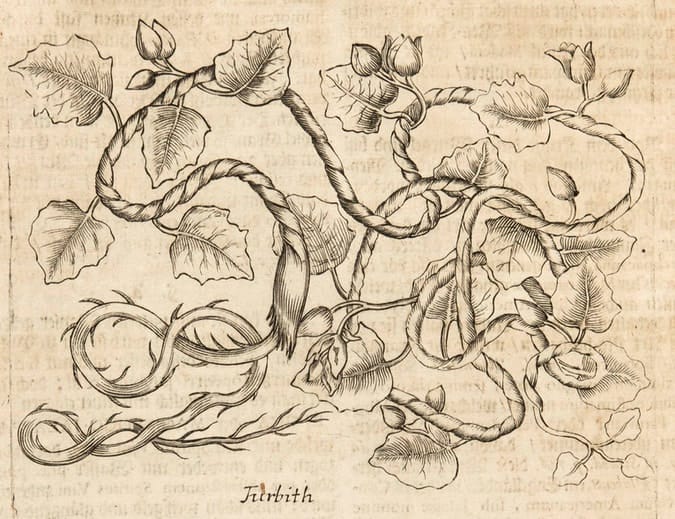 Museum Museorum, Valentini, 1704
Museum Museorum, Valentini, 1704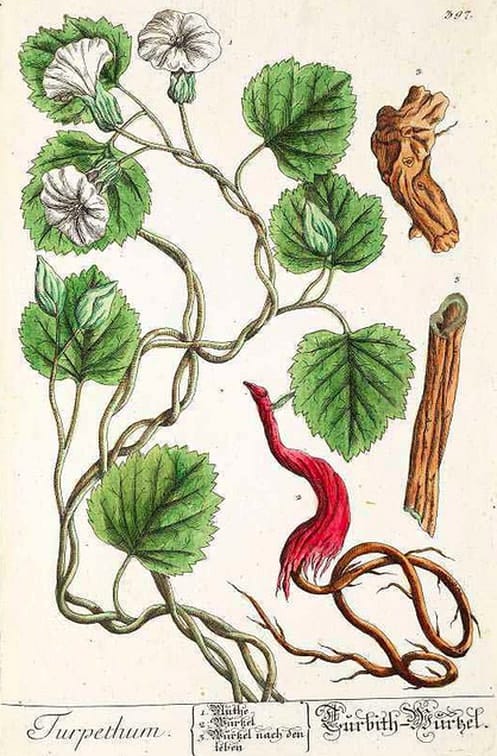 Blackwell, Herbarium Blackwellianum, 1760
Blackwell, Herbarium Blackwellianum, 1760
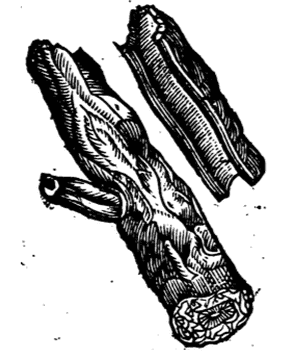 Turbith Root
Turbith RootHerbario nuovo, 1667 |
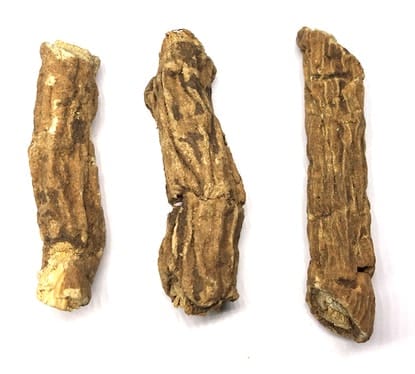 Turpeth root
Turpeth root(Calcutta Unani College, Adam, 2019) |

Botanical name:
Operculina spp.
Two types are recognised, White and Black.
- White Turbith: O. turpethum (syn. Ipomoea turpethum, Convolvulus turpethum, Merremia turpethum, Spiranthera turpethum; Convolvulus triqueter, C. anceps, Ipomoea anceps, I. diplocalyx, I. turpethum var. anceps, I. silvana var. heterophylla, Operculina triquetra, Argyreia alulata)
- Black Turbith: O. petaloides
Parts used:
Root-bark (pith removed).
Most commonly used ion the market is the white Turbith. The best is gummy, and came form Turkey. A lesser type is from India.
Temperature & Taste:
Very Warm, dry. Sweet, Bitter, Pungent
Classifications:
3K. EXPECTORANT
Preparers and Purgers of Phlegm
Preparers and Purgers of Melancholy
Laxative, Purgatives and Cathartics
Uses:
1. Clears Phlegm and Damp:
-phlegm obstructing the Chest with Cough, Asthma
-Phlegm and Damp clouding the Brain and senses
-Wind-Damp joint pain including Arthritis and Rheumatism
-Phlegm masses including Scrofula and Lymphadenitis
-Edema and Jaundice from a cold and damp cause
2. Purges Melancholy:
-Melancholy, Psychosis
-Syphilis, Scabs, Leprosy and other Skin diseases
-adjunct for Tumors, Fibroids and Cancers
Dose:
1. Always begin with lesser doses.
2. Some modern sources give very small doses (10–30mg) (Ayurvedic Medicine, The Principles of Traditional Practice)
3. Avicenna said the powder was better for purging Phlegm, but the decoction is better to purge Burnt Humors (Melancholy).
4. “The use of Turbith produces dryness … Therefore it is used with Almond oil” (Avicenna)
5. “Masarjawaih states that Turbith purges out thick and viscous humours. Some other physicians are of the opinion that it purges out immature humours from the Hips. It is more correct to say that Turbith purges out thin phlegm, but if it is made more potent by mixing with dry Ginger or any other strongly pungent drug, it would also be able to purge out the tbick and immature humours. Turbith alone cannot purge out the thick humours except when they (the thick humours) are lying in the stomach and intestines”. (Avicenna)
Powder: 500mg–3 grams (1-4 scruples was traditionally prescribed; Avicenna said up to 2 drams [7 grams]).
Infusion: 3–6 grams (1–3 drams was traditionally prescribed)
Comment:
Avicenna said Turbith will only expel Phlegm from the Stomach and Intestines if used alone. It can purge Phlegm and Melancholy from various regions of the body when combined with Ginger or similar pungent medicines along with other herbs appropriate to the intention.
Substitutes:
1. Jalap
2. Rhubarb
3. Much like Mecoachan, but stronger (Pomet)
4. ‘Many people use Thapsia for the Turbith’. (Pomet)
5. Scammony was sold as ‘Pseudo-Turbith‘ when Turbith was unavailable.
6. Its use in the Western Tradition is equivalent to Pinellia Ban Xia in TCM. The latter may be a good substitute.
Correctives:
1. Ginger; Mesue said Ginger helped correct Turbith while enhancing its ability to purge crass pituitous humors (damp). Avicenna added: “Some drugs have a mild purgative action and need a helping drug which when added to it heightens the action, e.g. Turpeth root. It has a weak purgative action and is incapable of dissolving strongly. Hence it removes what is thin in the phlegm but when dried Ginger is added to it, with the help of its intensity, it quickly evacuates a humour which is highly viscous and vitreous”.
2. Pepper; Cinnamon; Cardamon, Grains of Paradise
3. ‘Mitigators’ of Turbith, which both correct and delay it: Whey, Sweet Almond oil, Syrup of Violets, Raisins, Sugar.
4. Mastic
5. Chebulic Myrobalan.
6. Almond oil (Avicenna)
7. In Unani the root-bark is considered corrected if boiled in Almond oil
8. In Unani, Sterculina urens and the bark of Acacia arabica are also used.
Preparation:
Turbith was not generally prepared
1. Prepared with Almond oil.
Turbith is sometimes boiled in Almond oil in Unani medicine. This method of preparation mitigates its harshness and corrects it.
“The use of Turbith produces dryness … Therefore it is used with Almond oil” (Avicenna)
2. A way to Prepare from The Medical Formulary of al Samarqandi:
“One may soak mashed turpeth. It is then put in the sun for days until the water takes up its strength… Then that water is thickened in the sun so that it becomes very gentle and light in nature and far from being dangerous.”
Main Combinations:
Commonly combined with Ginger (see Correctives above)
1. To purge Phlegm from the body:
i. Phlegm, Asthma, Edema, Turbith with Ginger
ii. Turbith with Ginger, Mastic and Sugar (as in Compound of Turbith)
iii. Turbith with Triphala, Caradamon, Cinnamon, Ginger, Long Pepper, Senna (Ayurveda)
2. Asthma:
i. from Cold-Phlegm, Turbith, Ginger, Mastic (as in Powder of Turbith)
ii. Turbith, Agaric, Mastic, Aniseed (as in Electuary of Turbith and Agaric)
iii. Turbith, Licorice, Violet (see research below)
3. Edema:
i. Turbith, Ginger, Potassium bitartrate
ii. Turbith, Ginger, Parsley seed
4. For Damp Joint pain:
i. Turbith was combined with Colchicum, Rhubarb, Ginger, Mastic and Cinnamon (as in Turbith Powder with Rhubarb)
ii. Rheumatism, Lumbago, Turbith with Cardamon, Cinnamon, Clove, Black Pepper (Ayurveda)
5. Rheumatic and Paralytic diseases from Damp, Turbith with Ginger, Chebulic Myrobalan
6. Melancholy and Psychosis:
i. Melancholy, Turbith, Chebula
ii. Turbith, Dodder, Aniseed, Lapis Lazuli
iii. Turbith with Dodder, Gentian, Wormwood, Aniseed, Mastic (Unani)
7. Scrofula, Turbith with Sarcocolla, Agaric, Galbanum, Sal Ammoniac (Unani)
8. Chronic skin diseases, Turbith, Madder, Picrorhiza, Boerhaavia
9. Hemorrhoids, Turbith with Triphala (Ayurveda)
10. Obesity, high cholesterol:
i. Turbith with Bdellium, Ginger, Turmeric (Ayurveda)
ii. Turbith, Fennel, Celery seed, Ginger, Long Pepper
11. Jaundice, Turbith with Tribulus seed (Ayurveda)
Major Formulas:
Infusion for Mixed Humors Compound (Mesue)
Decoction of Thyme (Mesue)
Powder of Turbith (Avicenna)
Powder to Purge Phlegm (Unani)
Powder of Three Solutives (Augustine Pharmacopoeia)
Compound of Turbith with Anise
Powder to Purge in Ascites (Nicholas)
Powder for Ascites (Isaac)
Powder for Uterine Pain of Turbith
Troches for Back and Sacral Pain (Nicholas)
Electuary of Polypody
Electuary of Socrates
Electuary of Turbith (Zenon)
Electuary of Turbith and Agaric
Electuary for Asthma (Gereonis)
Indian Electuary Lesser (Mesue)
Triphala Electuary to Purge Phlegm and Black Bile
The Count’s Night Pills (Unani)
Magisterial Imperial Pills
Pills of Agaric (Mesue)
Pills of Agaric (Avicenna)
Pills of Violet (Unani)
Pills for Arthritis (Nicholas)
Pills for Ascites with Fever
Pills to Cleanse the Chest
Foetid Pills Major of Galen
Greater Polycrest Pills
Avipattikara Churna (Ayurveda)
Kaisor Guggulu (Bdellium Youthful Pill) (Ayurveda)
Punarnavadi Guggulu (Boerhaavia and Bdellium Pills) (Ayurveda)
Cautions:
1. Not used during Pregnancy or in young Children
2. Not used in Yin deficiency
3. Use cautiously and avoid overdose
Toxicity:
LD50 of ethanol extract was 1917.66 mg/kg in mice.
Main Preparations used:
Diaturbith, Diaturbith with Rhubarb, Pills of Turbith, Vinegar of Turbith, Extract
1. Extract of Turbith:
Extracted with Brandy and evaporated to the consistency of an extract.
Dose: ½ – 1 scruple (600–1200mg)
|
‘This drug, which bears the Sanskrit names of Triputa, “three-angled”, Trivrit, “three-fold,” Kutarana, Tinti and Nindika, is described in the Nighantas as pungent, cathartic, dry, sweet and hot; a dispellent of wind, fever, phlegm, bile and melancholy, and bitter and digestive. Sanskrit writers mention two varieties, Sveta— ” white,” and Krishna or Shama,”black”; the latter kind bears the names of Kala, Kalaparni and Kalameshi, and is described as a violent purgative. Its source has not been satisfactorily ascertained, but it is supposed to be the root of Lettsomia atropurpurea, Clarke, a native of Nipal and Sikkim. I.Turpethum is sacred to Siva, to whom the flowers are offered by the Hindus. It is one of the most common native cathartics, and has probably been in use all over India from a very early date. The usual method of administration is to rub down about a drachm of the root or stem with water, and add to it some rock salt and ginger, or sugar and black pepper. Under the name of Turbud, an Arab corruption of Triputa, Mahometan writers also mention two kinds, white and black, and direct the black to be avoided on account of its poisonous properties, which are said to resemble those of Hellebore. As regards the properties of Turbud they say that it is a drastic purgative of phlegmatic humors and bile; its action is promoted by combination with ginger; it is particularly beneficial in rheumatic and paralytic affections. Combined with chebulic myrobalans it is useful in melancholy and dropsies. Ainslie says— “The Convolvulus Indicus alalus maximus had long a place in the British Materia Medica, but of late years has fallen into disuse. I find it mentioned by Avicenna under the name of Turbud; but the first among the Arabs who prescribed it was Mesue (see Spreng., Rei Herbaria, Vol. 1, p. 249), also |
Rhazes (c. 173). Alston in his Materia Medica speaks of turpeth as a strong and resinous cathartic, and recommended in his days in gout, dropsy and leprosy. The plant is known to the modern Greeks by the name of [?]; it is a native of the Society and Friendly Isles, as well as of India, of the New Hebrides and of New Holland. Virey, in his Histoire Nalurelle des Medicaments (p.184), speaks of the root of the Convolvulus Turpethum as more drastic than the common jalap, which, however, it does not seem, is to be found in India.” (Mat. Ind. II., p.384.) Wallich, Gordon, and Glass considered this drug to be of considerable value as a cathartic. Sir W. O’Shaughnessy (Beng. Disp., p. 504), found it so uncertain in its operation that he pronounced it unworthy of a place in the Pharmacopoeia. In this opinion he is undoubtedly correct, as the active resins are present in the root in a much smaller proportion than in jalap, but as the drug is very cheap it might be used with advantage for preparing the commercial resin. Turpeth when administered by the mouth excites irritation of the stomach with nausea, colic, and watery, mucous stools; in excessive doses it excites inflammation of the gastro-intestinal mucous membrane and bloody dejections. Like jalap it is an hepatic stimulant, increasing the secretion of biliary matter and rendering it more watery. Being a hydrogogue cathartic it is useful for the removal of dropsical effusions, and in such cases it acts best in combination with ginger and bitartrate of potash. The dose should be about double that of the ordinary jalap powder of commerce, equal to from 4 to 5 grains of the resin. (Pharmacographia Indica, Dymock, 1891) |
